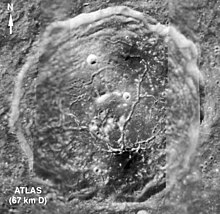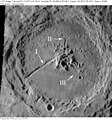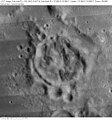Floor-fractured crater
As a floor-fractured crater (German break ground craters , abbreviated FFC ) is referred to in the Astrogeologie a special surface structure in which at an impact crater the crater interior through of aufdringendes below Magma was changed whereby groove-and fracture-like structures emerged.
FFCs on the moon
The peculiar structures corresponding to craters on the moon were noticed early on. From the 1970s onwards, it was theorized that FFCs were impact craters modified by volcanic activity . In an article from 1976, the geologist Peter H. Schultz first classified the craters with such structures into 6 classes, examined their spatial distribution and surroundings and explained the formation of the FFCs in connection with the formation of the Maria . The classes introduced by Schultz are:
- Examples of the FFC classes
FFC I: Petavius with Rimae Petavius ( Lunar Orbiter 4 )
FFC II: Briggs
( Lunar Orbiter 4 )FFC IV-A: Bohnenberger
( Lunar Orbiter 4 )FFC IV-B: Gaudibert
( Lunar Orbiter 4 )FFC V: Repsold
( Lunar Orbiter 4 )FFC VI: Pitatus
( Lunar Orbiter 4 )
- Class I.
- Relatively fresh appearing impact craters with terraced walls, central mountain and ejecta ceilings , similar in type to Copernicus . The central mountain is either a ring of individual peaks, crescent-shaped, or the peak has a dip. The crater floor is flat and has grooves that run radially outward from the central mountain, or a system of polygonal grooves. Examples include Atlas , Einstein A , Schlüter , Cardanius , Petavius , Humboldt and Lavoisier E
- Class II
- Smaller craters than class I with flat hills inside, often recognizable as sunken old ramparts, broken up by radial grooves or a polygonal fracture zone surrounded by concentric grooves. Central mountains are rarer and less pronounced than in class I, and central depressions also occur. The crater rim has a pronounced steep step. Examples are Encke , Davy , Briggs and Vitello .
- Class III
- Craters of this class have a relatively wide depression on the inside of the crater rim. The depression usually does not form a closed ring and is best pronounced in the direction of a neighboring mare. Inside the depression, the crater floor is flat; the boundary between the depression and the flat interior can also be pronounced as an elevation, as with Haldane . The interior usually has polygonal breaks that end at the edge of the depression. Further examples of this class are Gassendi , Posidonius , Doppelmayer , Lavoisier , Runge and Warner .
- Class IV
- Class V
- Class VI
FFCs on terrestrial planets
Meanwhile, FFCs have been identified not only on the moon, but also on Mars . No secure identifications could yet be made on Mercury . On Venus and Earth, little corresponding structures are to be expected because of the intensive geological changes. After all, structures of an FFC are seen in the Manicouagan Crater in Canada and in the Sudbury Basin in Canada. It is now assumed that the formation of FFCs generally belongs to the early phase of terrestrial planets , in which on the one hand there are numerous active magmatic large provinces and on the other hand, impacts of large bodies are still frequent.
literature
in chronological order in descending order
- J. Korteniemi, M. Aittola, T. Öhman, J. Raitala: Floor-fractured craters on the terrestrial planets - the Martian perspective. 40th ESLAB, First International Conference on Impact Cratering in the Solar System , Proceedings. ESA Special Publication SP-612 2006, pp. 193-198, PDF
- Andrew J. Dombard, Jeffery J. Gillis: Testing the viability of topographic relaxation as a mechanism for the formation of lunar floor-fractured craters. In: Journal of Geophysical Research . Vol. 106 (2001), Ed. E11, pp. 27901-27910, bibcode : 2001JGR ... 10627901D
- RWWichman, PH Schultz: Floor-fractured craters in Mare Smythii and west of Oceanus Procellarum: Implications of Crater Modification by Viscous Relaxation and Igneous Intrusion Models. In: Journal of Geophysical Research Vol. 100 (1995), Ed. E10, pp. 21201-21218, bibcode : 1995JGR ... 10021201W
- JL Hall, SC Solomon, JW Head: Lunar Floor-Fractured Craters: Evidence for Viscous Relaxation of Crater Topography. In: Lunar And Planetary Science XII (1981), pp. 389-391, bibcode : 1981LPI .... 12..389H
- PH Schultz: Floor-fractured lunar craters. In: The Moon. Vol. 15 (1976), pp. 241-273, bibcode : 1976 Moon ... 15..241S
Web links
- Floor-fractured craters on The Moon Wiki
Individual evidence
- ↑ Korteniemi, et al .: Floor-fractured craters. 2006, p. 196
- ↑ DL Orphal, PH Schultz: An alternative model for the Manicouagan impact structure. In: 9th Lunar and Planetary Science Conference, Houston, Tex., March 13-17 , 1978, Proceedings. Vol. 2, pp. 2695-2712, bibcode : 1978LPSC .... 9.2695O
- ↑ RW Wichman, PH Schultz: Floor-fractured crater models of the Sudbury Structure, Canada - Implications for initial crater size and crater modification . In: Meteoritics Vol. 28 (1993), No. 2, pp. 222-231, bibcode : 1993Metic..28..222W
- ↑ Korteniemi, et al .: Floor-fractured craters. 2006, p. 193







